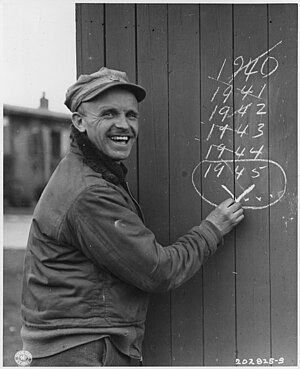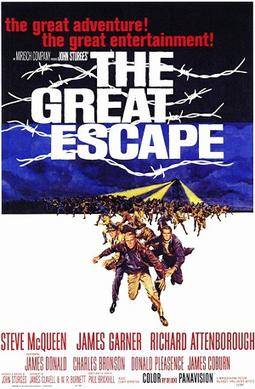
The Great Escape is a 1963 American epic war suspense adventure film starring Steve McQueen, James Garner and Richard Attenborough and featuring James Donald, Charles Bronson, Donald Pleasence, James Coburn, Hannes Messemer, David McCallum, Gordon Jackson, John Leyton and Angus Lennie. It was filmed in Panavision, and its musical score was composed by Elmer Bernstein.
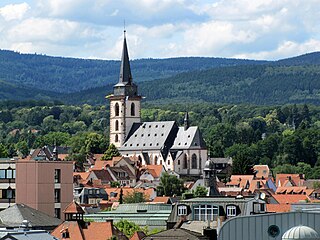
Oberursel (Taunus) (German:[oː.bɐ.ˈʊʁ.zl̩] ) is a town in Germany and part of the Frankfurt Rhein-Main urban area. It is located to the north west of Frankfurt, in the Hochtaunuskreis county. It is the 13th largest town in Hesse. In 2011, the town hosted the 51st Hessentag state festival.
Marlag und Milag Nord was a Second World War German prisoner-of-war camp complex for men of the British and Canadian Merchant Navy and Royal Navy. It was located around the village of Westertimke, about 30 km (19 mi) north-east of Bremen, though in some sources the camp's location is given as Tarmstedt, a larger village about 4 km (2.5 mi) to the west. There were also American merchant seamen detained here as well as some U.S. Navy personnel.
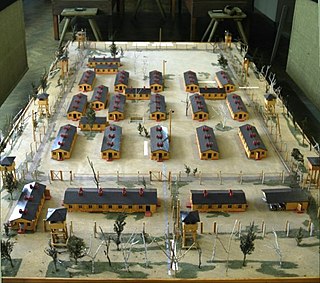
Stalag Luft III was a Luftwaffe-run prisoner-of-war (POW) camp during the Second World War, which held captured Western Allied air force personnel.
Squadron Leader Roger Joyce Bushell was a South African RAF aviator. He masterminded the "Great Escape" from Stalag Luft III in 1944, but was one of the 50 escapees to be recaptured and subsequently murdered by the Gestapo.
Camp King is a site on the outskirts of Oberursel, Taunus, with a long history. It began as a school for agriculture under the auspices of the University of Frankfurt. During World War II, the lower fields became an interrogation center for the German Air Force. After World War II, the United States Army also used it as an interrogation center and intelligence post. The United States CIA used the site to test drugs including LSD on prisoners as part of Project BLUEBIRD, the predecessor to MKUltra. In 1968, it became the command and control center for the United States Army Movements Control Agency - Europe (USAMCAEUR). Today it has been rebuilt as a German housing area.
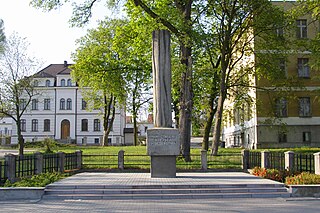
Oflag XXI-B and Stalag XXI-B were World War II German prisoner-of-war camps for officers and enlisted men, located at Szubin a few miles southwest of Bydgoszcz, Poland, which at that time was occupied by Nazi Germany.
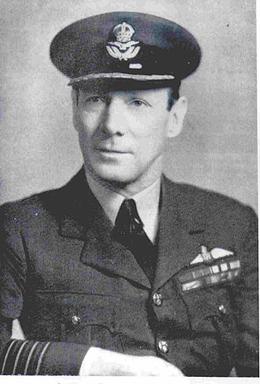
Harry Melville Arbuthnot Day, was a Royal Marine and later a Royal Air Force pilot during the Second World War. As a prisoner of war, he was senior British officer in a number of camps and a noted escapee.
James Brian Buckley, was a Royal Navy Fleet Air Arm pilot who became a notable prisoner of war during the Second World War. He died during an escape attempt on 21 March 1943.
Major John Bigelow Dodge, also known as "the Artful Dodger", was an American-born British Army officer who fought in both world wars and became a notable prisoner of war during the Second World War, surviving The Great Escape.

Flight Lieutenant Sydney Hastings Dowse MC was a Royal Air Force pilot who became a prisoner of war and survived The Great Escape during the Second World War.

The Stalag Luft III murders were war crimes perpetrated by members of the Gestapo following the "Great Escape" of Allied prisoners of war from the German Air Force prison camp known as Stalag Luft III on March 25, 1944. Of the 76 successful escapees, 73 were recaptured, most within several days of the breakout, 50 of whom were executed on the personal orders of Adolf Hitler. These executions were conducted within a short period following recapture.

Leslie George Bull, known as Johnny, Les or Lester Bull, was a British Vickers Wellington bomber pilot who was taken prisoner during the Second World War. He took part in the 'Great Escape' from Stalag Luft III in March 1944, but was one of the men re-captured and subsequently shot by the Gestapo.
Dennis Herbert Cochran, was an officer in the Royal Air Force and member of a British Armstrong Whitworth Whitley bomber crew who was shot down and taken prisoner during the Second World War. Notable for his part in the 'Great Escape' from Stalag Luft III in March 1944 when he almost reached Switzerland but was one of the men recaptured and murdered by the Gestapo.

William Jack Grisman was a British Vickers Wellington bomber crew member who was taken prisoner during the Second World War. He took part in the 'Great Escape' from Stalag Luft III in March 1944, but was one of the men re-captured and subsequently shot by the Gestapo.

Gordon Arthur Kidder, was a Royal Canadian Air Force officer, the navigator of a Vickers Wellington bomber, who was taken prisoner during the Second World War. He took part in the 'Great Escape' from Stalag Luft III in March 1944, but was one of the men recaptured and subsequently shot by the Gestapo.

Thomas Gresham Kirby-Green was a British Royal Air Force officer, the pilot of a Vickers Wellington bomber, who was taken prisoner during the Second World War. He took part in the 'Great Escape' from Stalag Luft III in March 1944, but was one of the men recaptured and subsequently executed by the Gestapo.
Thomas Barker Leigh was an Australian-born Handley Page Halifax bomber rear gunner who was taken prisoner during the Second World War. He took part in the 'Great Escape' from Stalag Luft III in March 1944, but was one of the men re-captured and subsequently shot by the Gestapo.

James Leslie Robert Long, known as Cookie, was a British Vickers Wellington bomber pilot who was taken prisoner during the Second World War. He took part in the 'Great Escape' from Stalag Luft III in March 1944, but was one of the men re-captured and subsequently murdered by the Gestapo.

Nazi Germany operated around 1,000 prisoner-of-war camps during World War II (1939-1945).
